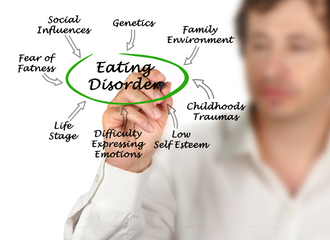Referring a patient for eating disorder treatment is a process that requires careful consideration. Here’s a brief guide to what clinicians need to know.
As a clinician, it’s incredibly important to understand when your client needs a higher level of care. It’s not easy making that decision and you know that it might be stressful and disruptive to their life.
You also know that eating disorders are life-threatening illnesses and transitioning your client to a specialized program can be transformative and beneficial for their physical, social, and mental health. When your client completes a treatment program and returns to your care, they’re often ready to do the important work of continuing recovery and building a fulfilling life.
In this post, we’ll review the warning signs of an eating disorder, the red flags that indicate your client may need a higher level of care, and the process of referring your client to The Renfrew Center or another place like it.
4 Questions to Consider Regarding a Higher Level of Care
- What is your client’s level of motivation for treatment or recovery?
- Are you trying to understand their concerns about a step up to a higher level of care or are you exploring their experiences with previous providers?
- Who does the support system consist of, and what are those individuals’ attitudes towards treatment? How will your client’s caregivers feel about their child going on medical leave and withdrawing from classes? Has their partner reported “seeing the signs” but doesn’t know how to provide support? Are the individuals in their support system on the same page?
- Have you identified who the treatment team consists of and created a collaborative relationship with the other members?
Know The Warning Signs
Many eating disorders go undetected and untreated in various settings due to stigma, lack of awareness, treatment inequities, and provider biases. Eating disorders are dangerous, and so it is important to recognize the warning signs and symptoms to diagnose and treat them as early as possible.
These signs may include:
- Fluctuations in weight
- Obsessive thoughts about food/calories, body size and shape, and exercise
- Rigid adherence to specific food or exercise rules, routines, and rituals
- Disappearing after meals
- Eliminating entire food groups or decreasing food variety
- Hiding or hoarding food
- Eating in secret/isolation
- Eating more/less than usual, or at a slower or faster pace
- Increased interest in recipes, food blogs, ingredients, baking or cooking (generally to be served to others)
- Isolating; withdrawing from friends and activities
- Menstrual irregularities
- Other physiological signs including cold hands/swollen feet; dehydration; dry skin/hair; discoloration of teeth or cavities; impaired immune function; swelling around salivary glands; difficulty concentrating; fainting; GI complaints; and sleep disturbances
Consider screening every client for eating disorder risk during intake. This can be accomplished easily and quickly by using the SCOFF questionnaire (Morgan, Reid and Lacey, 1999), which consists of 5 questions that can be posed by both professionals and non-professionals in either verbal or written form.
S: Do you make yourself Sick (induce vomiting) because you feel uncomfortably full?
C: Do you worry you have lost Control over how much you eat?
O: Have you recently lost more than 15 pounds in a 3-month period?
F: Do you believe yourself to be Fat when others say you are too thin?
F: Would you say that Food dominates your life?
If your client answers “YES” to 2 or more questions, your client is likely at risk for an eating disorder and further assessment is recommended by an eating disorder specialist. Be mindful that the SCOFF questionnaire is a self-report measure, which may not be effective with certain populations. It also does not inquire about over-exercise (or other purging methods), reveal weight history, or screen for every feeding and eating disorder in the DSM-5. A more thorough assessment might include the Eating Disorder Inventory (EDI-3), the Eating Disorder Examination Questionnaire (EDE-Q), and/or the Eating Disorder Diagnostic Scale (EDDS).
When it’s Time to Refer
The appropriate level of care for your client is determined by a variety of factors including the severity of medical issues, eating disorder behaviors, comorbid diagnoses, and level of suicide risk. Treatment should be provided in the least restrictive environment possible that still provides safe and effective services. If you are currently providing outpatient services, higher levels of care include intensive outpatient programs (IOP), partial hospitalization programs (PHP), residential treatment (RES), and inpatient hospitalization (IP).
Individuals who require a higher level of care for their eating disorder have typically reached a point of significant instability and their commitment to recovery can waver—literally from hour to hour. Denial and minimization are common experiences for those with eating disorders, and your client may not believe they are sick enough for a step up. A qualified eating disorder specialist can provide a thorough assessment to identify which level of care would best fit your client’s needs. Recovery can be difficult, but it is much less difficult when your client has the structure and the support they deserve.
Red Flags that indicate the need for a higher level of care:
- Ongoing restricting, bingeing, over-exercising, and/or purging without any improvement in an OP setting.
- Need for increased support, supervision, structure during and/or after meals
- Worsening of co-occurring diagnoses or harmful behaviors (e.g., trauma, substance use, self-injury, anxiety, and depression)
- Medical issues, regardless of body size (e.g., dizziness, ongoing weight loss, abnormal labs, decreased heart rate, or orthostasis)
- Presence of suicidality or other safety issues
- Inadequate support at home or significant conflict in the home environment
- Preoccupation with intrusive eating disorder thoughts for multiple hours a day
Referring to The Renfrew Center
To ensure your patient receives prompt attention, Renfrew has a streamlined referral and admissions protocol.
1. Reach Out to Renfrew
As soon as you think treatment may be indicated—and your patient is amenable—call The Renfrew Center’s Program Information Department at 1-800-RENFREW (736-3739), and a Program Information Coordinator will assist you.
2. Discuss Patient Needs
The Program Information Coordinator will ask for basic demographic information and an overview of the issues that led to the referral. We’ll also ask for insurance information so staff can provide you with a preliminary insurance benefits check. Once the health plan has verified coverage, we will speak with your patient or their supports to explain benefits and out-of-pocket costs, if any. If benefits are limited, we will explore other payment options at this time.
3. Schedule a Bio-psycho-social Evaluation
We will also schedule an appointment for a complete bio-psycho-social evaluation of your patient with a therapist to determine the appropriate level of care. Pre-admission laboratory testing and medical clearances, including an EKG, are required for residential and partial levels of care. Your patient will be sent a list of these requirements at the time the assessment is scheduled.
4. Discuss Treatment Goals
The Renfrew Center encourages collaboration with all referring professionals. Before admission, we will explore your treatment goals for your patient and, once they are admitted, we will discuss with you our plan of care and provide updates on the patient’s progress. We are always interested in your feedback and welcome your collaboration. When the patient is returned to you for ongoing care, you will receive a discharge summary that fully briefs you on their progress, treatment success, and our aftercare recommendations.
Conclusion
The Renfrew Center is here as a resource for both you and your clients. When you refer to Renfrew, you can feel confident knowing that patients will receive expert, evidence-based treatment from our compassionate clinical staff. With 19 sites and virtual treatment options available across the country, Renfrew provides clinically consistent care for all those in need.



